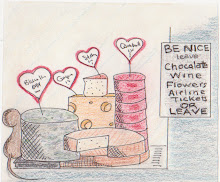JUST CHEESE
Colston Bassett
Colston Bassett are one of the smallest Stilton Dairies in the country. They buy milk from 5 farms surrounding the dairy. They have been buying from the same farms since the 1920s. Since 1920, there have only been 4 head cheesemakers at Colston Bassett: Tom Coy, Ernie Wagstaff, Richard Rowlett and now Billy Kevan.
Their Stilton is more traditional than any other. The curd is hand-ladled before draining. This treats the curd more gently and preserves its structure, which results in a luscious, creamy texture when the cheeses are mature.
The cheeses they make for us are made with traditional animal rennet rather than vegetable rennet. Animal rennet is used by the most exacting cheesemakers because it makes better cheese. With Colston Bassett Stilton, the texture is more full-bodied when made with animal rennet and the flavour is deeper, more complex and longer lasting than that of cheeses made with vegetable rennet.
Brie de Meaux-France
Brie de Meaux has a tender, nutty in flavour, creamy texture and rustic rind. In the 19th century is was considered the finest cheese in Europe, thanks to the French statesman, Talleyrand, who introduced it at a diplomats' dinner. It is produced near Paris which has no doubt helped its reputation. Its color is pale yellow, reminiscent of straw. Its rind looks like white velvet. The taste is creamy and as the maturing process continues, one detects a subtle, nutty flavor.
Chevre de Palliot-Canada, Quebec
A slight tangy flavour that becomes more pronounced with age. Chevre de Paillot is a lactic cheese with a crumbly hard central core, and creamy brie like edges.
Cheshire-England
This dense, crumbly cheese derives its mild saltiness from the pastures of Cheshire. England's oldest-known cheese, it is reddish-orange in color and has a slightly tangy flavor. Cheshire is ripened for two to three month. Immensely popular and widely copied,
Mirabella-France
Pale yellow in color with a white-orange rind, it is a very rich and soft cheese with a supple yet firm consistency. It is well known for its delicate bouquet, however it does tend to have a strong, pungent aroma.. The flavour is creamy and full-bodied, especially if you choose to eat the rind (some prefer to trim it).
Oka-Canada, Quebec
Oka, a semi-soft, unpasteurized cow's milk cheese, is known as one of the most popular Canadian cheeses. It is produced from an original recipe brought by the Benedictine monks. These monks originated in Brittany, France, then moved to the village of Oka just outside of Montreal in Quebec to start a new monastery. Oka has a distinctive, full flavour, filled with delicate subtleties. It is mellow, smooth, creamy and a little bit nutty. However, it does tend to have a strong, pungent aroma.
Corsica-France
Corsica is a factory-produced soft cheese with a soft rind, made from ewe's milk. This cheese is very creamy inside in spite of is firmness
Cave Aged Gruyere- Switzerland
Made from rich, unpasteurized, Alpine cow's milk, this Grand Gruyere Reserve has been aged for at least 1 year, compared with the average 4-6 months. A rustic, somewhat oily rind gives way to firm, smooth textured cheese which is slightly aromatic with a robust, assertive flavour.
Etorki-France
Etorki is supple and close textured. Etorki is aged from 3-6 months from fine, cut curd pressed in plastic molds, vertically stacked to press curd and expel whey. After a two-hour brine bath, it is rubbed with salt and later in brine soaked cloths. Etorki is oily with butterfat, yet firm and supple with a burnt caramel sweetness and a creamy texture.
Manchego-Spain
Manchego is Spain's most famous cheese. Produced in La Mancha in Central Spain, true Manchego is made from 100% sheep's milk. The abundance of wild herbs on Central Spain's grazing lands gives Manchego a special taste and aroma. Its flavour is zesty and exuberant while its texture is firm but not dry. Manchego can be recognized by the zigzag pattern etched into its rind. This is created by the rippled surface of the press used in the manufacture of the cheese. Underneath the inedible rind, the interior is ivory colour with few small holes.
Subscribe to:
Post Comments (Atom)











No comments:
Post a Comment